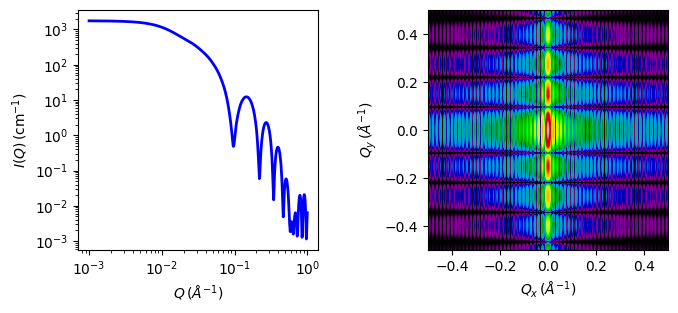hollow_cylinder¶
Parameter |
Description |
Units |
Default value |
|---|---|---|---|
scale |
Scale factor or Volume fraction |
None |
1 |
background |
Source background |
cm-1 |
0.001 |
radius |
Cylinder core radius |
Å |
20 |
thickness |
Cylinder wall thickness |
Å |
10 |
length |
Cylinder total length |
Å |
400 |
sld |
Cylinder sld |
10-6Å-2 |
6.3 |
sld_solvent |
Solvent sld |
10-6Å-2 |
1 |
theta |
Cylinder axis to beam angle |
degree |
90 |
phi |
Rotation about beam |
degree |
0 |
The returned value is scaled to units of cm-1 sr-1, absolute scale.
Definition
This model provides the form factor, \(P(q)\), for a monodisperse hollow right angle circular cylinder (rigid tube) where the The inside and outside of the hollow cylinder are assumed to have the same SLD and the form factor is thus normalized by the volume of the tube (i.e. not by the total cylinder volume).
where the averaging \(\left<\ldots\right>\) is applied only for the 1D calculation. If Intensity is given on an absolute scale, the scale factor here is the volume fraction of the shell. This differs from the core_shell_cylinder in that, in that case, scale is the volume fraction of the entire cylinder (core+shell). The application might be for a bilayer which wraps into a hollow tube and the volume fraction of material is all in the shell, whereas the core_shell_cylinder model might be used for a cylindrical micelle where the tails in the core have a different SLD than the headgroups (in the shell) and the volume fraction of material comes fromm the whole cyclinder. NOTE: the hollow_cylinder represents a tube whereas the core_shell_cylinder includes a shell layer covering the ends (end caps) as well.
The 1D scattering intensity is calculated in the following way (Guinier, 1955)
where scale is a scale factor, \(H = L/2\) and \(J_1\) is the 1st order Bessel function.
NB: The 2nd virial coefficient of the cylinder is calculated based on the outer radius and full length, which give an the effective radius for structure factor \(S(q)\) when \(P(q) \cdot S(q)\) is applied.
In the parameters,the radius is \(R_\text{core}\) while thickness is \(R_\text{outer} - R_\text{core}\).
To provide easy access to the orientation of the core-shell cylinder, we define the axis of the cylinder using two angles \(\theta\) and \(\phi\) (see cylinder model).

Fig. 31 1D and 2D plots corresponding to the default parameters of the model.¶
Source
hollow_cylinder.py
\(\ \star\ \) hollow_cylinder.c
\(\ \star\ \) gauss76.c
\(\ \star\ \) sas_J1.c
\(\ \star\ \) polevl.c
References
L A Feigin and D I Svergun, Structure Analysis by Small-Angle X-Ray and Neutron Scattering, Plenum Press, New York, (1987)
Onsager, Ann. New York Acad. Sci., 51 (1949) 627-659
Authorship and Verification
Author: NIST IGOR/DANSE Date: pre 2010
- Last Modified by: Paul Butler Date: September 06, 2018
(corrected VR calculation)
Last Reviewed by: Paul Butler Date: September 06, 2018